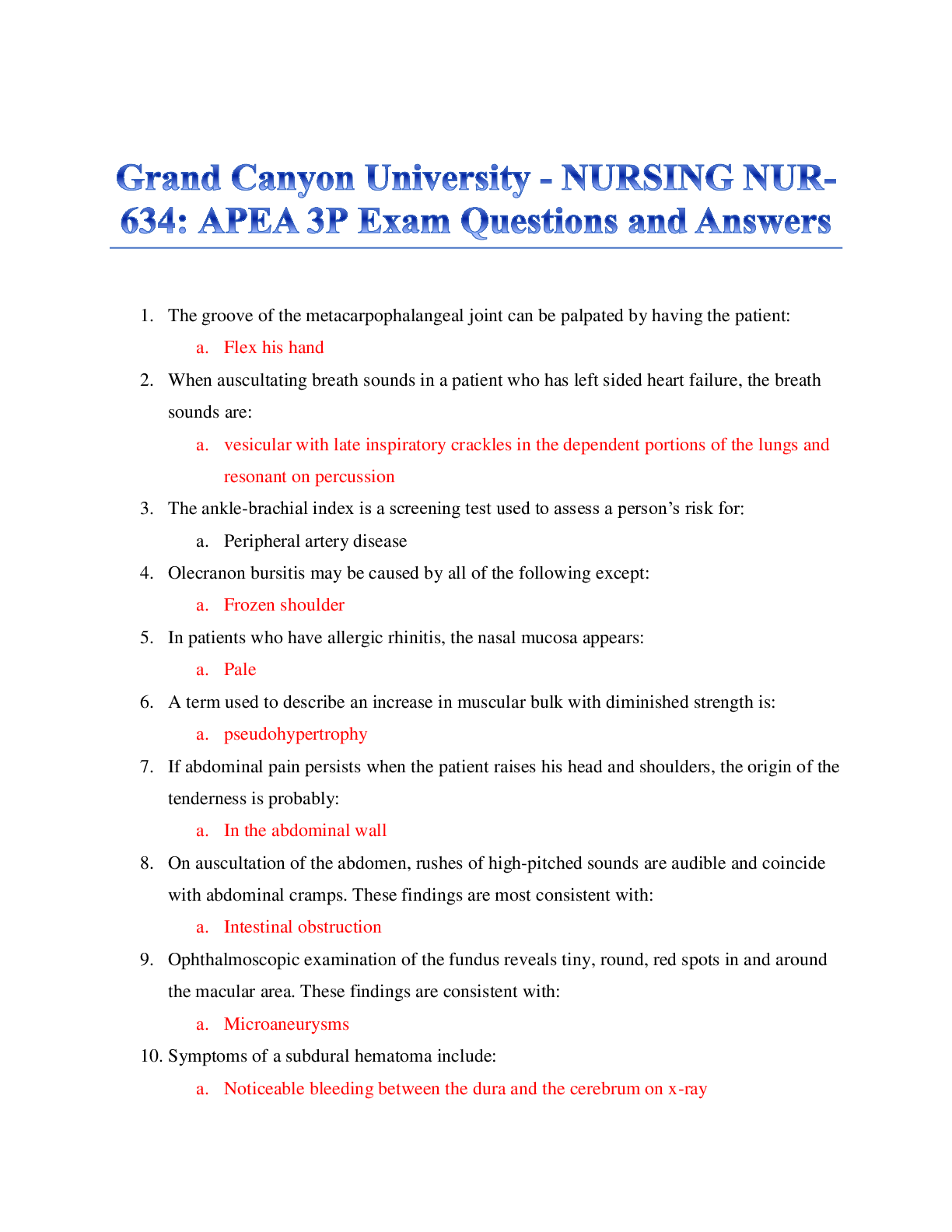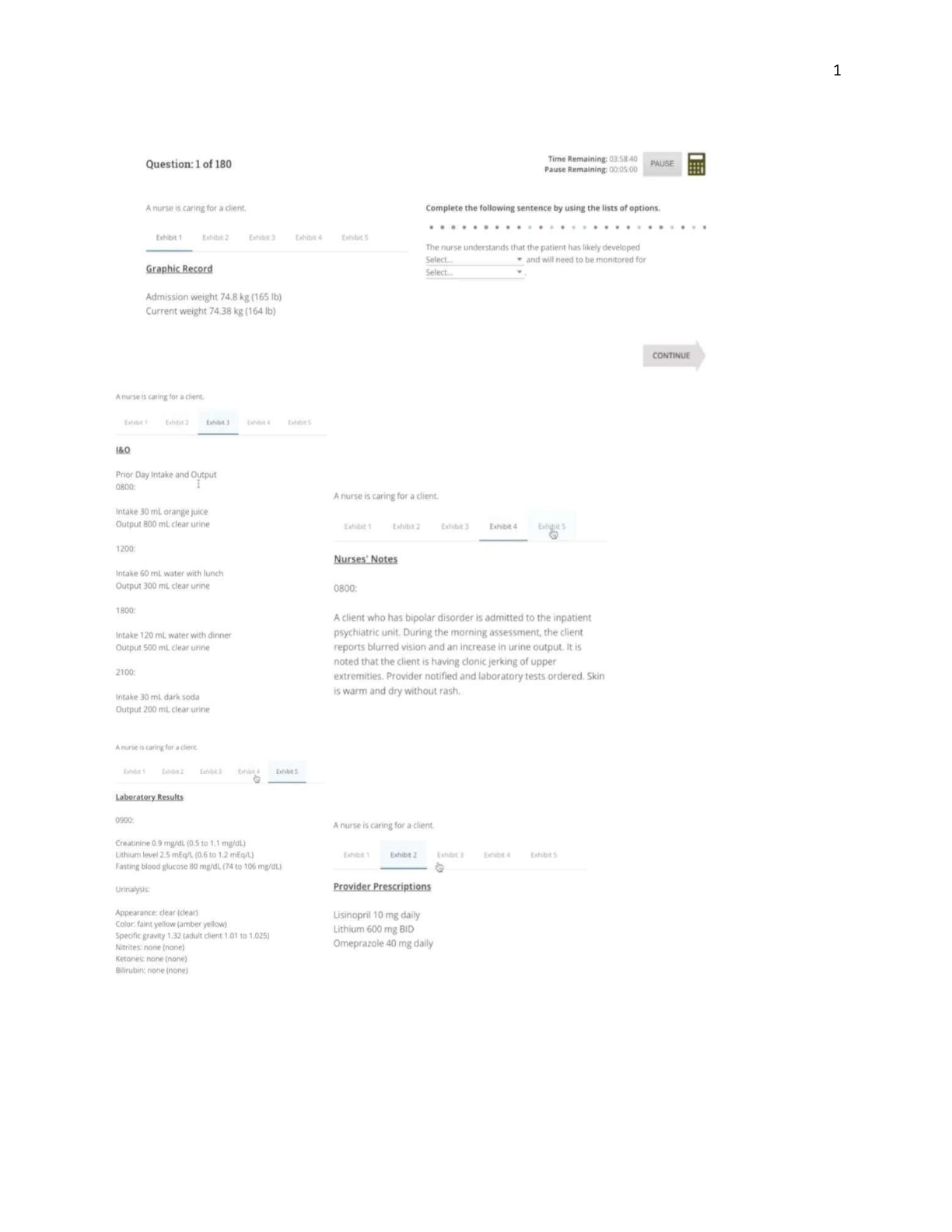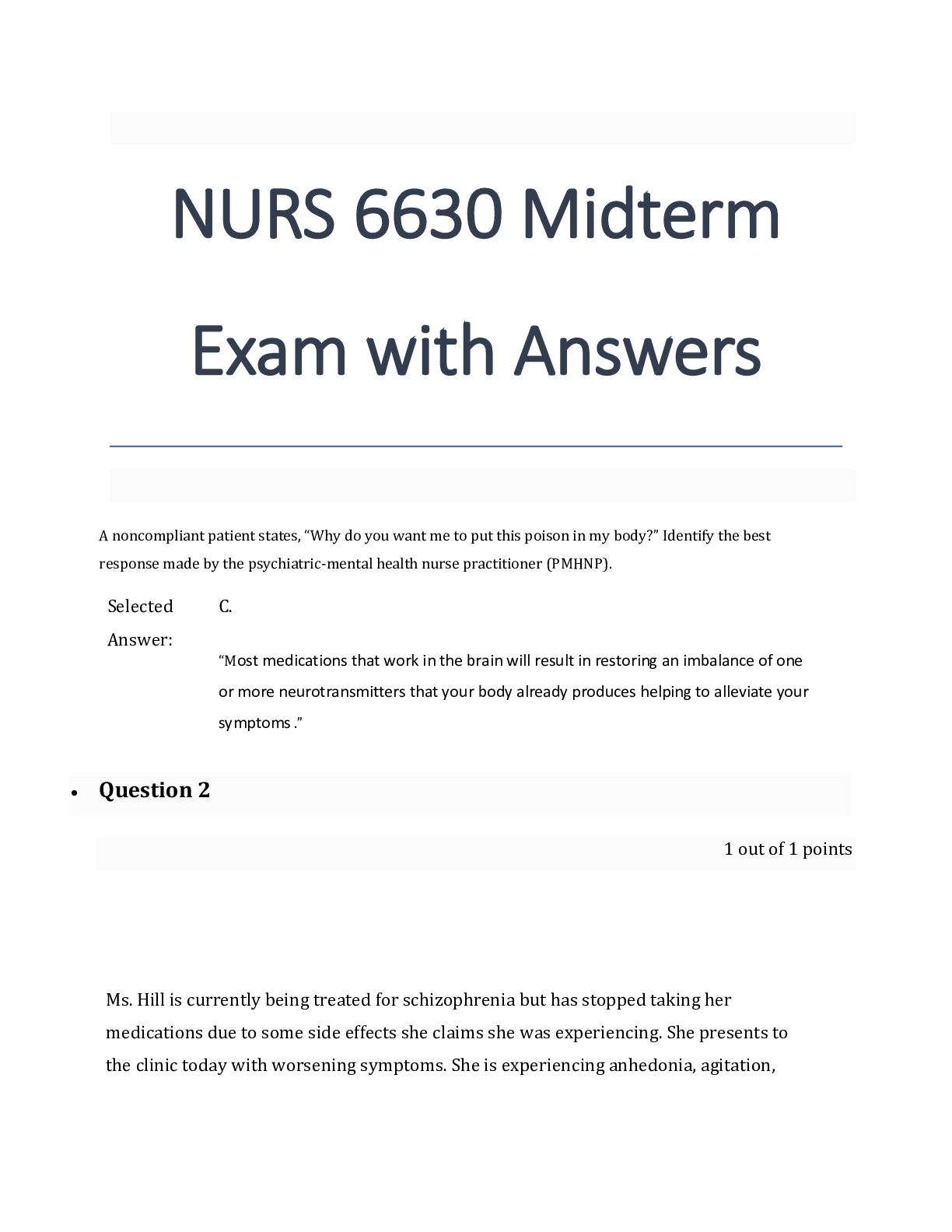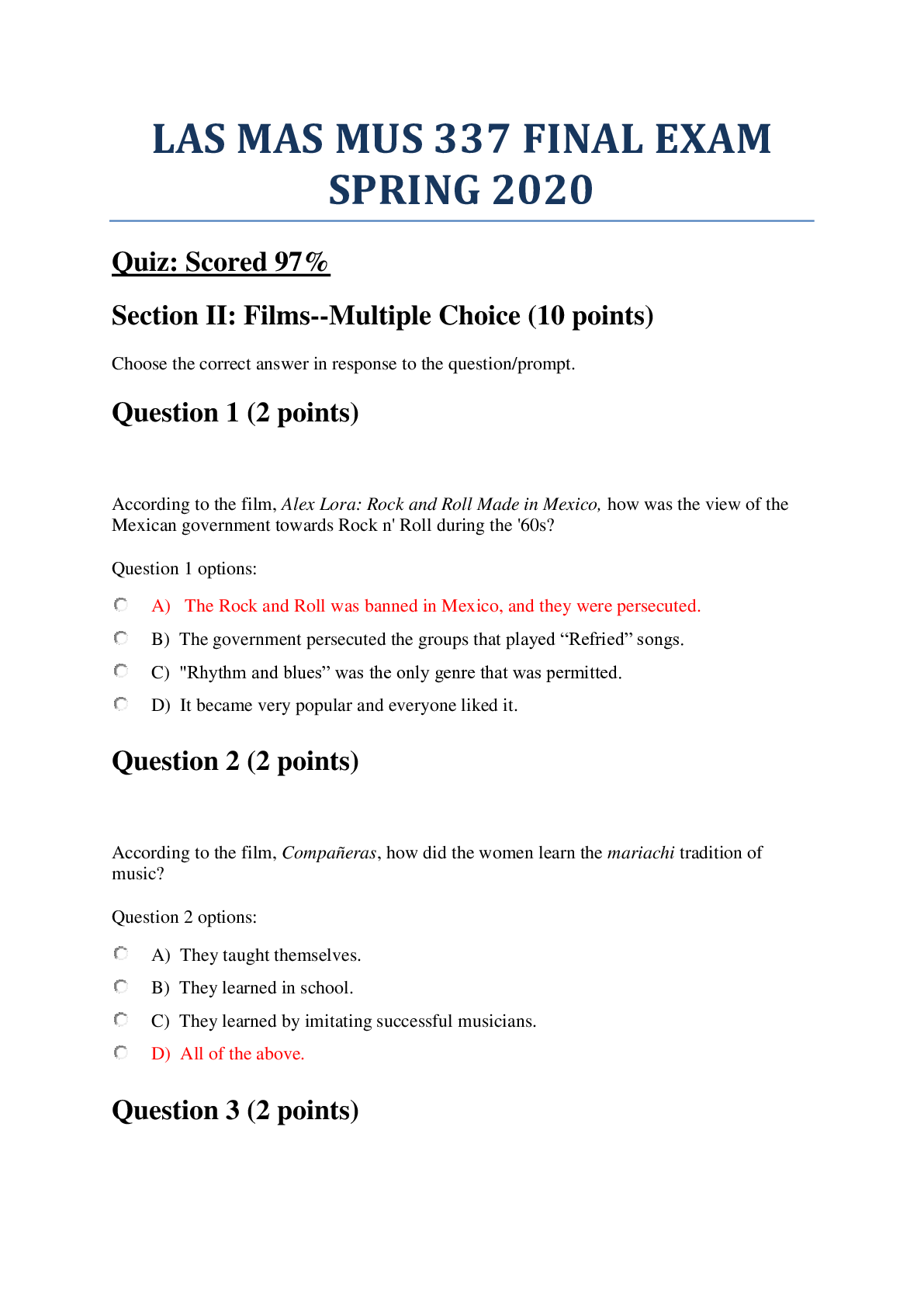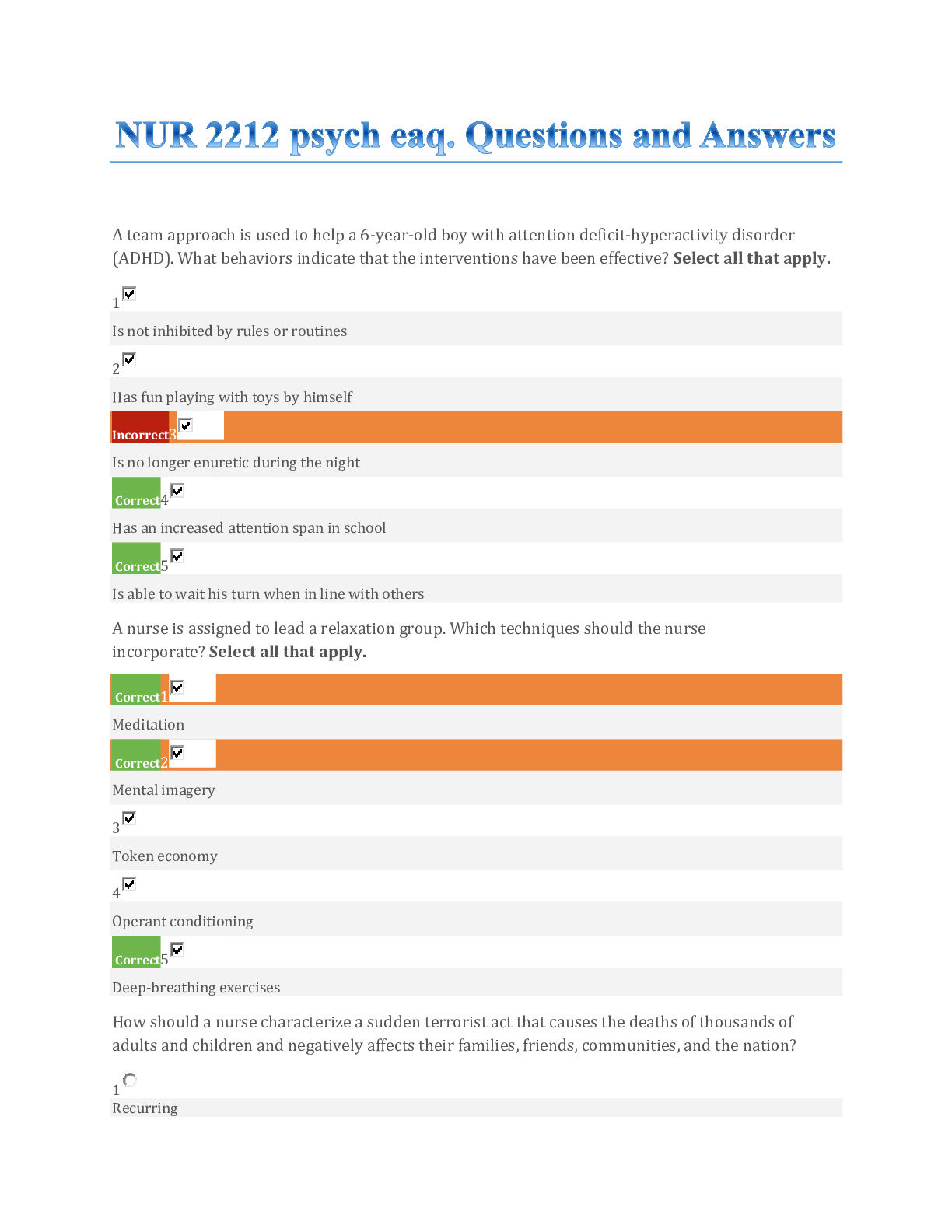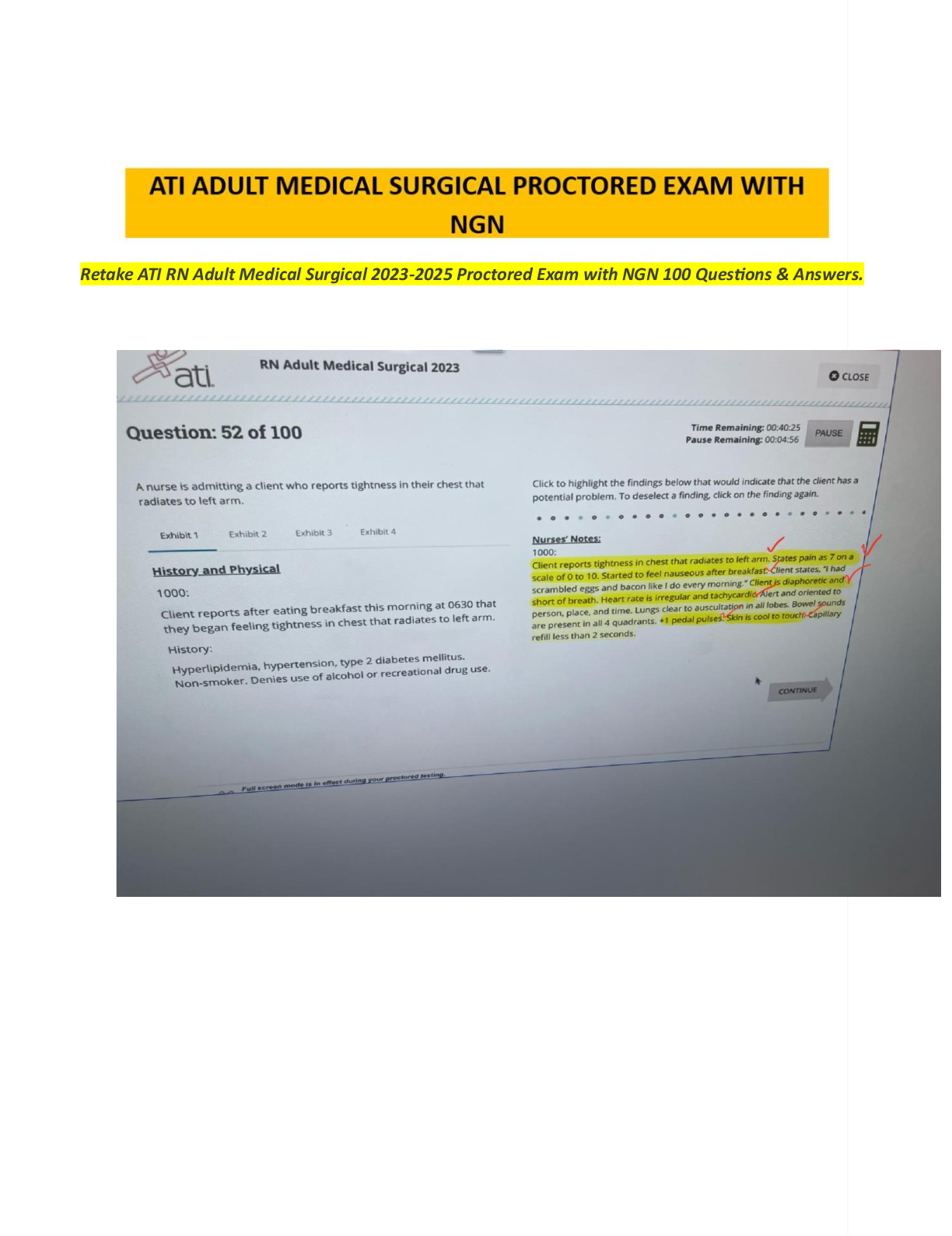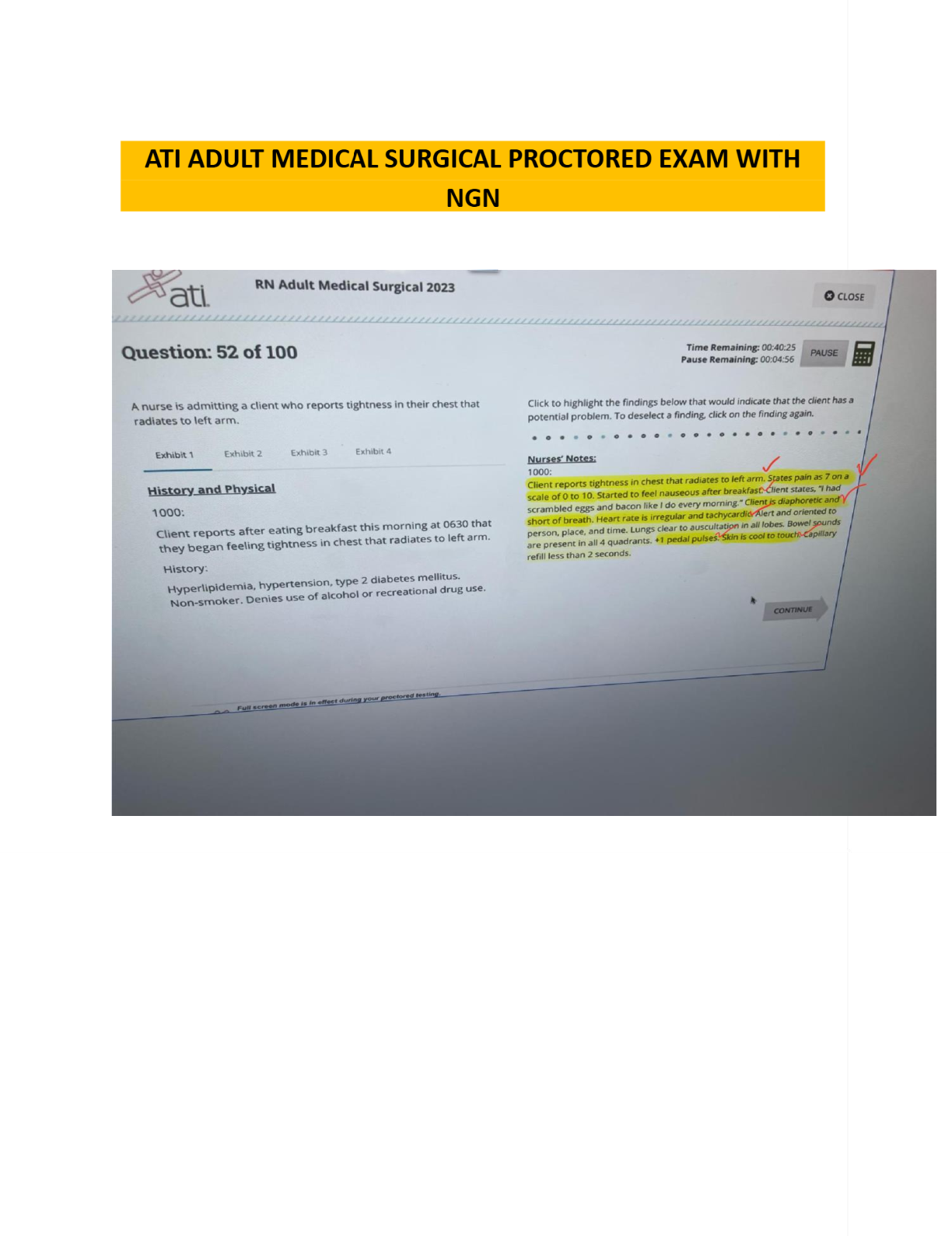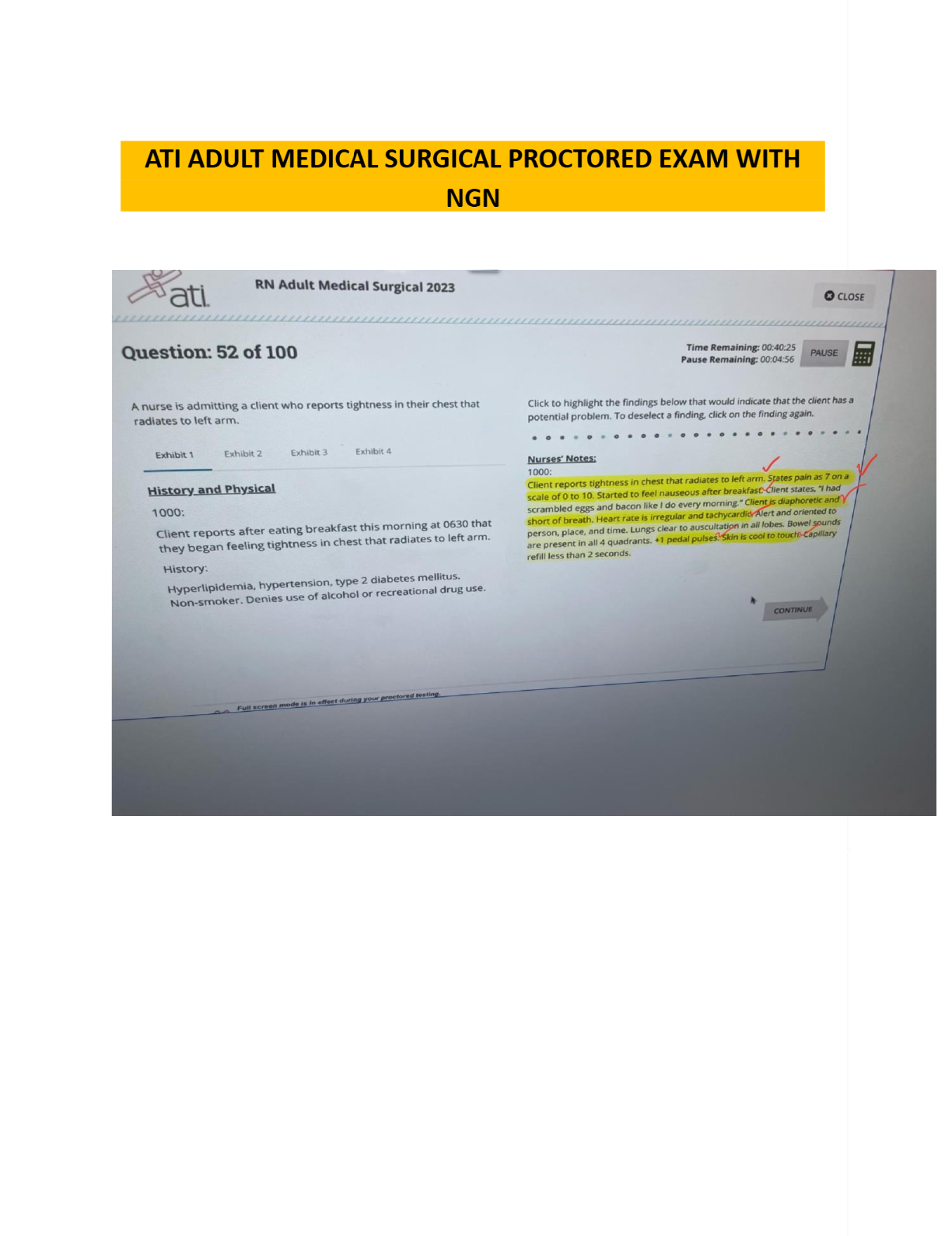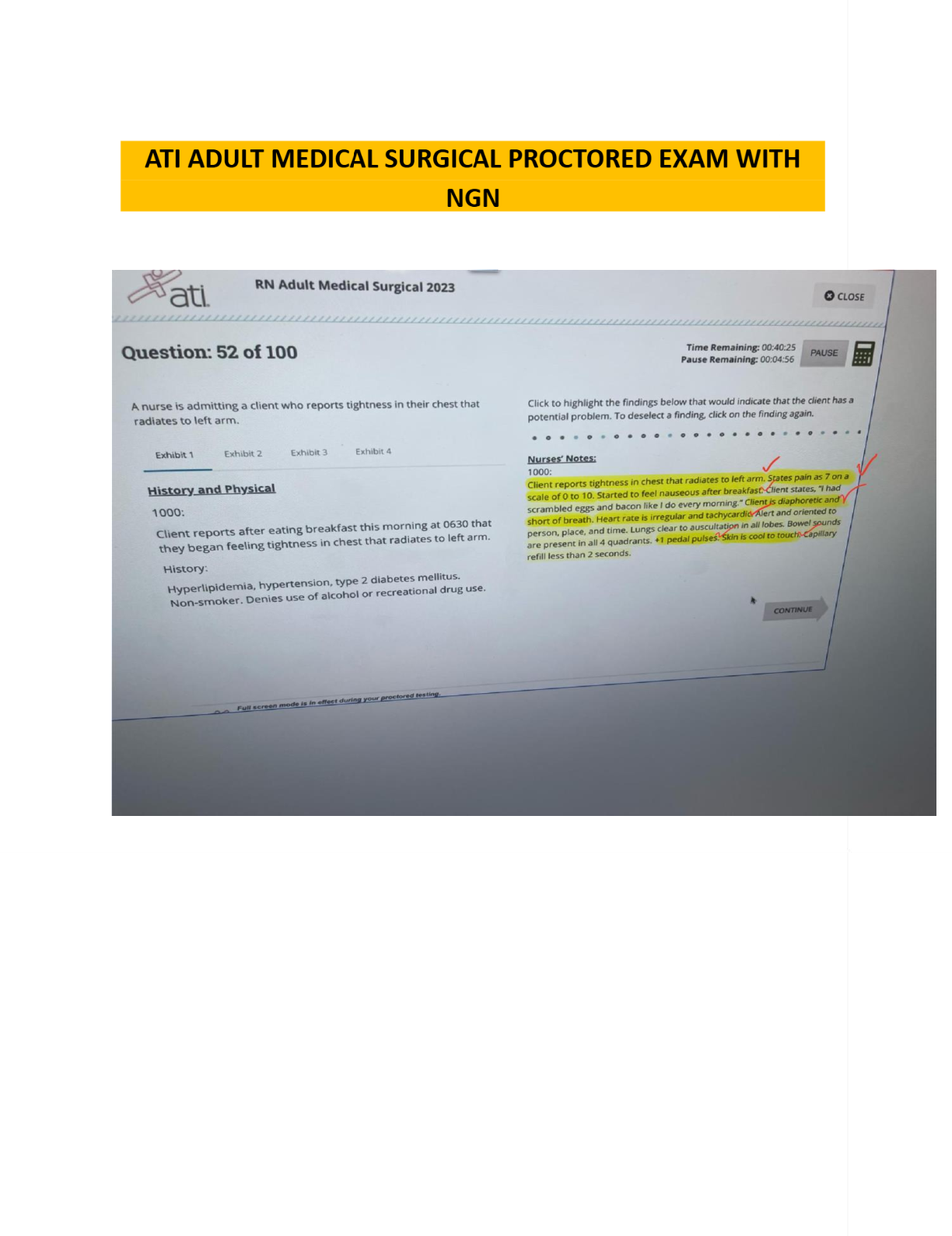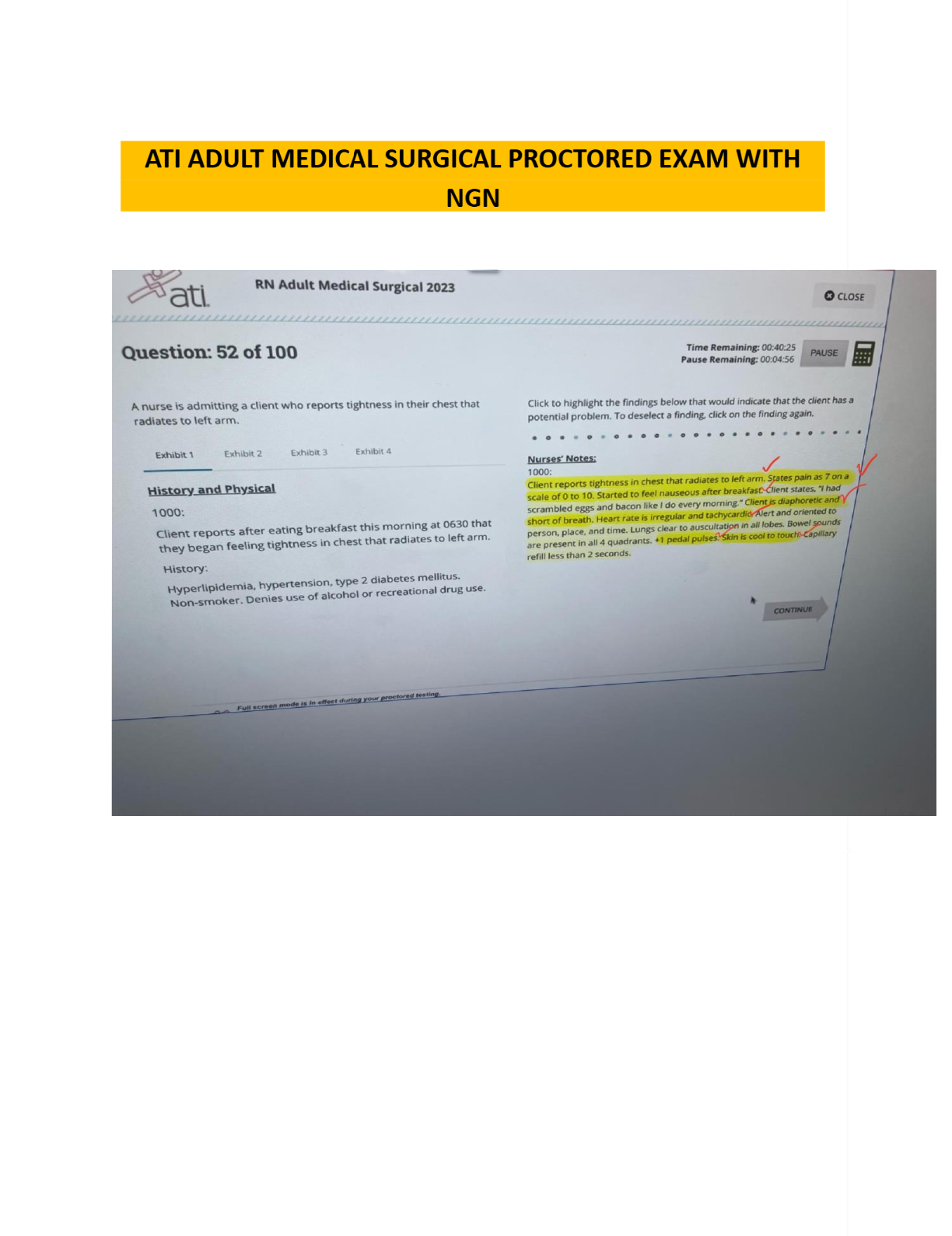Questions and Answers > Arizona State University AST 113 ASTRONOMY Lab 9
Document Content and Description Below
Arizona State University AST 113 ASTRONOMY Lab 9 Lab 9 Question 1 1 out of 1 points Lab 9 Figure 1 - Click Image to Enlarge Finding Jupiter We will start this lab by finding the planet Jup ... iter. In this lab, you will use the Starry Night software to learn about and answer Question s related to Jupiter and its moons. You should have a general familiarity with Starry Night before attempting this portion of the lab. To become more familiar with Starry Night, access the tutorial exercise within the software. Begin this activity in Phoenix, Arizona, at sunset on June 1, 2014. To do this, select Phoenix, United States from the Viewing Location drop-down menu. Then enter the date in the Time and Date field and click the Sunset button. Look toward the west by clicking the W viewing direction button located on the button bar across the top of your screen or by pressing the W key on your keyboard. The screen will pan toward the west. Select a playing speed of 300 times normal time by selecting 300x from the Time Flow Rate drop-down menu. Click the Stop time mode button when the sun has set, the stars have come out, and dusk is almost over. Finally, click open theOptions tab in the left side pane, open the Constellations panel, and turn on Stick Figures and Labels to show the constellations. After you have had a chance to explore.Lab 9 Figure 2 - Click Image to Enlarge Finding Jupiter (cont.) Click the Find tab on the left side pane. A list of planets should appear. Those that are highlighted are currently up in your evening sky. Those that are not highlighted are not up in the sky at this time. Check the boxes to turn on the label for Jupiter and its orbit. (Hover the mouse to see each check box's description.) The click on the black arrow in the grey circle on the far right of the same line. A pop-up menu will appear. Select Centre to center on Jupiter. This action pans the screen and centers Jupiter. You can now zoom in on Jupiter either by using the Zoom control at the far right of the control panel or by right-clicking (Control-clicking for Mac) Jupiter on the Find tab and selecting Magnify. Click the information icon (i) next to Jupiter on the Find tab to read a short description of the planet Jupiter. Then select the Info tab on the left side pane and click the plus sign (+) icon (a gray arrow for Mac) to expand each of the information categories. Use the information on the Info tab to answer the Question s. Another option is to simply click on the black arrow in the grey circle next to Jupiter in the Find tab and select Show Info from the resulting pop-up menu. Pictorial definitions of opposition and conjunction, used in Question s 12) and 13), can be found in the following link: http://astro.unl.edu/naap/ssm/modeling2.html After you have had a chance to explore, use the Starry Night software to answer these Question s.What is the radius of Jupiter? Question 2 1 out of 1 points Given that Earth’s radius is 6378 km, what percentage of Earth’s radius is Jupiter’s radius? Question 3 1 out of 1 points What is the mass of Jupiter in relation to Earth? Question 4 1 out of 1 points What is the angular size of Jupiter as seen from Earth? Question 5 1 out of 1 points What is Jupiter’s orbit size? Question 6 1 out of 1 points What is the length of a sidereal day for Jupiter? Question 7 1 out of 1 points What is the length of a solar day for Jupiter? Question 8 1 out of 1 points How long is a year on Jupiter? Selected Answer: 11.86years Correct Answer: 11.86 years Question 9 1 out of 1 points In which constellation is Jupiter on June 1, 2014? Question 10 1 out of 1 points What is Jupiter’s current apparent magnitude? Question 11 1 out of 1 points How far is Jupiter currently from Earth? Question 121 out of 1 points For a superior planet, the distance at opposition is calculated by subtracting the Earth’s distance from the Sun (1 au) from the planet’s orbit size. What is Jupiter’s distance at opposition? Question 13 1 out of 1 points The distance at conjunction is calculated by adding the planet’s orbit size to Earth’s distance from the Sun (1 au). What is Jupiter’s distance at conjunction? Question 14 1 out of 1 points Lab 9 Figure 3 - Click Image to EnlargeJupiter's Moons For the next section of the lab, we will use the Starry Night software to learn about Jupiter's moons. Starry Night will display 39 of Jupiter's moons. Keep in mind that Jupiter actually has more than 60 moons and more will probably be discovered. We want a closer look at the four largest moons (also called the Galilean satellites, first viewed by Galileo in 1610): Io, Europa, Ganymede, and Callisto. Click the plus sign (+) icon (a gray arrow for Mac) next to Jupiter in the Find side pane. This action lists Jupiter's moons. Click the first checkbox for each of the Galilean satellites (Io, Europa, Ganymede, and Callisto). This action labels the moons on your screen. To see both the planet and the moons, you might have to pan out by using the Zoom control buttons at the far right of the control panel. Keep in mind that the moons might be out of sight behind the planet itself. In that case, use the3000x time speed setting on the control panel to move time forward so that the moons are clearly visible. Remember that as you move time forward, you might need to select Hide Horizon and Hide Daylight from the View menu. Let's take a closer look at each moon. Double-click Io in the list to center Io on your screen. Use the Zoom control buttons to get a close-up view. Click the information icon (i) in the left side pane to read a short description of this moon. Then select the Info tab on the left side pane and click the plus sign (+) (a gray arrow for Mac) to expand the different information categories. Repeat these steps to view each of the four Galilean satellites. Note how small the ratio of each moon's mass is when compared to the mass of Jupiter itself. Although the Galilean satellites are some of the largest moons in the solar system, their mass ratios are very small and have little gravitational effect on Jupiter. In contrast, Earth's moon-to-planet mass ratio is one of the largest in the solar system at 0.0123 (or 1.23%). Note how close Io is to its parent planet in multiples of Jupiter's radius. Compare this with our own moon, whose distance from Earth is more than 60 times Earth's radius. When a large moon is too close to its parent planet, the tidal forces are so great that they try to rip the moon apart. The critical distance, known as the Roche limit, is the closest distance a large moon can exist in orbit around a planet without being ripped to shreds. Moons are thus generally found outside the Roche limit; ring systems are usually found within the Roche limit. An interesting point to make is that although Io is outside the Roche limit, it is relatively close and is, therefore, subjected to tremendous tidal forces. These forces cause internal friction and generate heat. Thus Io has a hot interior and is volcanically active.You will need the information provided about Io in the description section of the Info side pane to answer some of the Question s. Remember that the last moon you checked in the Find side pane will be the one that appears in the Info side pane. If the information for Io is not currently displaying in the Info side pane, uncheck and re-select its leftmost box in the Find side pane. After you have had a chance to explore, use the Starry Night software to answer these Question s. What is the radius of Io? Question 15 1 out of 1 points Next select Europa. Again, remember that the last moon you checked in the Find side pane will be the one that appears in the Info side pane. Given Earth’s Moon’s radius of 1737 km, what is Europa’s radius in multiples of Earth’s Moon’s radius (divide Europa’s radius by Earth’s Moon’s radius)? Question 16 1 out of 1 points Select Ganymede in the Find side pane. What is the mass of Ganymede? Question 17 1 out of 1 points Select Callisto in the Find side pane. Given that the mass of Earth’s Moon is 0.0123 Earth masses, what is the mass of Callisto in multiples of Earth’s Moon's mass? Question 18 1 out of 1 points What is the orbit size of Callisto in astronomical units? Question 19 1 out of 1 points What is the orbit size of Europa in kilometers? Question 20 1 out of 1 points How long is a sidereal day on Io? Question 21 1 out of 1 points How long is a solar day on Ganymede? Question 22 1 out of 1 points What percentage of Io’s surface is covered by volcanoes? Question 23 1 out of 1 points How many active volcanoes were found on Io by Voyager 1? 8 Question 24 1 out of 1 points What is the average surface temperature of Io? Question 25 1 out of 1 points What is the temperature on Io near active volcanoes? Question 26 1 out of 1 points What is the maximum height of volcanic eruption plumes on Io? Question 27 1 out of 1 pointsLab 9 Figure 4 - Click Image to Enlarge Jupiter's Satellite Orbital Characteristics For the next section of the lab, we will use the Starry Night software to observe some of Jupiter's satellite orbital characteristics. Zoom back out so that you can see Jupiter and its moons. From the Labels drop-down menu select Planets-Moons to see the names of other moons. Double-clickJupiter in the Find side pane to center on Jupiter; zoom out slowly to see how many moons you can observe. Select the 3000x time speed on the control panel and watch the moons orbit Jupiter. (If you haven't already turned off the Horizon and Daylight, select Hide Daylight and Hide Horizon from the View drop-down menu.) For best results, so that the smaller moons will be displayed, Jupiter should cover about a third of your screen. Watch the moons orbit Jupiter for a bit. The tilting is a result of our local perspective. You can remove this effect by selecting Orientation from the Options drop-down menu, and then selecting Ecliptic. Why do the moons move from side to side rather than in circles around Jupiter? This also has to do with perspective. Because Jupiter's satellite orbital plane lies along the ecliptic (the plane of our solar system), we can observe Jupiter only from the side. Let's take a closer look at satellite orbits. To better visualize the satellite orbital motion, enable both the first and second set of checkboxes in the Find side pane for each of the four Galilean satellites; this action labels and traces their respective orbits around Jupiter. Again, you might have to adjust the Zoom control to better view the orbital plane. Animate the orbits by selecting a time speed of 3000x. The fastest moon moves so quickly around Jupiter that we can often note a change in its position during a single evening's observing session. Slowly movetime forward using the 300x or 3000x time speeds until just before the moon begins to pass behind the limb of Jupiter. Double-click the moon to center it, then zoom in and observe this event slowly using the 30x time speed. If this occurs on the dark side, you will have to take extra care with your observations. To see some different viewing perspectives of the moons, right-click (Controlclick for Mac) Jupiter and select Graph Elongation of Moons. The graph shows the angular separation between the four Galilean satellites and Jupiter. Notice the high frequency for the fastest moon. To calculate maximum elongation, turn on the Angular Separation tool by selecting it from the cursor tool drop-down menu. Center your pointer on Jupiter and then click and drag to the farthest extent of the moon's orbit (make sure that the orbit trace is on). The angular separation will be displayed. You can move time forward with the time speed controls on the control panel, or you can simply grab the graph and drag to the left or right. You can also expand the horizontal resolution of the graph by clicking the plus and minus indicators at the top left of the graph. To increase the vertical resolution, grab the bottom of the graph and pull down. By moving the graph back and forth to look for different alignments, you can answer the following Question s. Which of the four Galilean satellites travels the fastest? Question 28 1 out of 1 points Which of the four Galilean satellites travels the slowest? Question 29 1 out of 1 points Set your date and time for June 1, 2014, at 1:00 PM (It is important that your computer is set to Phoenix time). Moving forward, at what time does Io begin passing behind Jupiter’s limb?(Ignore the hint in the walkthrough about adding 2 hours to these times.) Question 30 1 out of 1 points At what time does Io complete its pass behind Jupiter’s limb? Question 31 1 out of 1 points About how much time passed between when Io began to pass behind the limb of Jupiter to when Io was completely obscured? Question 32 1 out of 1 points What is the amount of time it takes for a complete cycle of Ganymede? Question 33 1 out of 1 points What is the amount of time it takes for a complete cycle of Europa? Question 34 1 out of 1 points What is the maximum elongation of Callisto? Question 35 1 out of 1 points Starting from June 1, 2014, at 1:00 PM, what is which time is a viewing opportunity to see all moons on the same side of Jupiter? (To find the first viewing opportunity using the graph, expand the horizontal graph by clicking on the "+" button in the upper left corner and move time forward until all the lines are above the central line.) Or you could just look at the moons to see when they are all on one side. Make sure the moons are not dark (not in Jupiter's shadow). You want all of the moons to be on one side and illuminated by the sun. Question 36 1 out of 1 points Lab 9 Figure 5 - Click Image to Enlarge Jupiter's Orbital Characteristics We will use the Starry Night software to observe the characteristics of Jupiter's orbit. Hide the graph from the top of the screen by dragging its lower border up until the graph disappears. Return to using the Adaptive cursor by selecting it from the drop-down cursor tool menu. Use the Zoom control at the far right of the control panel to zoom back out to full-scale view. Right-click (Control-click for Mac) Jupiter and select Orbit. This action shows Jupiter's orbital path as seen from Earth. Make sure that the Horizon and Daylight are turned off. You should still be locked on to Jupiter. If not, right-click (Control-click for Mac) the planet Jupiter and select Centre. To maintain the proper perspective, select Orientation from the Options dropdown menu and then select Ecliptic. Plot the Ecliptic on the sky by selecting View/Ecliptic guides and then choosing The Ecliptic. Enter June 1, 2014 in the Time and Date field and click the Sunset button. Note the constellation that Jupiter is in on this date. Select 1 days from the Time Flow Ratedrop-down list and click the Play time mode button. If you need to slow down or speed up, adjust the Time Flow Rate field as needed. You should see Jupiter locked in the center of your field of view as it movesacross the starry background. The planet should complete a full revolution in less than a minute. For a superior planet such as Jupiter, it is of interest to determine the dates of conjunction and opposition. Conjunction is when the planet lines up with the Sun as viewed from Earth. This occurs when the planet is on the opposite side of the Sun as compared to Earth. Opposition is when the planet is on the same side of the Sun as us, but beyond the Earth so that it appears high in our night sky around midnight. This is the best position for observing the planet (being high in the night sky and positioned closest to Earth as a result of its orbit). To determine the date of conjunction, step through the orbit using the Run Time Forward and Step Time Forward buttons on the control panel until the planet lines up with the Sun (it won't be exact, because the planet usually passes just above or below the Sun). You might find it helpful to step forward and backward one day at a time until you have the best alignment. Use this method to find the next date of conjunction for Jupiter. Record the date of next conjunction and the constellation that Jupiter is in on that date. Next we will view the bigger picture. To view the position of Jupiter as seen from outer space and compare it to the positions of the other planets, open the Favouritesmenu and select B-Solar System then Outer Solar System. Click the Stop time mode button and move the date back to the date of next conjunction that you just identified. Use the Zoom control to zoom in so that Jupiter's orbit fills the screen. On the Find tab, enable both the planet and orbit checkboxes for Earth. Earth and its orbit should appear. Centre on the Sun and zoom in until Jupiter's Orbit fills the screen. To determine the next date of opposition, step forward one day at a time until Earth is directly between the Sun and Jupiter. Try to imagine a straight line from the Sun, through Earth, to Jupiter. Although this method is not very precise, it will give you a general idea of when opposition will occur. Note the date of next opposition. You will need it to answer the Question . Here is a link to a Wikipedia picture show conjunction and opposition for planets exterior to Earth's orbit. http://en.wikipedia.org/wiki/File:Positional_astronomy.svg After you have had a chance to explore, use the Starry Night software to answer these Question s. In what constellation is Jupiter on June 1, 2014? Question 37 1 out of 1 points What is the date of next conjunction for Jupiter, starting after June 1, 2014? Question 38 1 out of 1 points In what constellation is Jupiter on the date of next conjunction? Question 39 1 out of 1 points What is the date of next opposition for Jupiter, starting from June Question 400 out of 0 points Lab 9 Figure 6 - Click Image to Enlarge Flying to Jupiter In the final section of this lab, we will explore from Jupiter's surface. Let's see what a day (technically referred to as a solar day) would be like on Jupiter. The easiest way to experience a solar day is by watching a sunset, taking note of the date and time, watching another consecutive sunset, and then calculating the time difference between the two events. For the purposes of this exercise, make sure that the date is set to June 1, 2014, click the Sunset button, and turn off planet labels and elliptical tracks. Right-click (Control-click for Mac) Jupiter and select Go There from the menu. Note: You can animate the journey by first deselecting the Only animate intra planet changes checkbox under File/Preferences/Responsiveness. Be sure that your horizon is turned on so that you can see the photorealistic surface panorama. View the surface of Jupiter by selecting Other from the Viewing Location drop-down menu and then selecting The Surface of, Jupiter from the View From drop-down menu. Type 0N, 0E in the latitude longitude tab. After arriving on the Surface of Jupiter, click the W viewing direction button on the button bar or press the W key on the keyboard. Next, select 1 minute from the Time Flow Rate drop-down list and click the Play time mode button. When the Sun is near setting, click the Stop button. Use the Step Forward and Step Backward time mode buttons until you see the Sun just starting to set. You might have to select a smaller unit of time until the Sun is just touching the horizon. Note the date and time of this event. Continue on tothe next sunset, note the time, and calculate the time difference between the two events. This difference is the length of a solar day on Jupiter. Record this information (you will need it to answer the Question s). If you are unable to see the Sun to the west during sunset, first click the Sunset button; click the checkbox to the left of the Sun in the Find side pane to label the Sun; then pan to the left (SW) or right (NW) until you see the Sun. If you still have trouble locating the Sun, right-click (Control-click for Mac) the Sun in the Find side pane and select Centre. You will have to unlock the Sun before continuing with this activity. The easiest way to unlock is to simply grab the sky (click and hold the left mouse button) and then move the mouse a little bit in any direction. The solar day is not the same as the sidereal rotation period of a planet. This is because the solar day takes into account both the rotation of the planet and the revolution of the planet around the Sun. Your calculation of a solar day can now be compared to the length of a sidereal day found in the Info side pane earlier in this activity. To determine the revolutionary period, or a planet's "year," we will return to the solar system view. From the Favourites menu, select C-The Planets/Outer Planets/Outer Solar System. Select 1 Days from the Time Flow Rate drop-down list (or something slightly slower), click the Play time mode button, and then note the time it takes for the planet to return to its original position (you might have to increase the number of days depending on the speed of your computer). You might find it easiest to align the planet to the furthest left or right before starting. Write down your observation (you will need it to answer the Question s). After you have had a chance to explore, use the Starry Night software to answer these Question s. When did the first sunset take place at 0N, 0E on Jupiter (make sure that your date and time were set to sunset in Phoenix on June 1, 2014, this is about 2:30 UT, June 2 on Jupiter - BTW: it is also 2:30 UT on Earth as well)? Selected Answer: June 2, 2014; 4:44 UT Correct Answer: June 2, 2014; 4:44 UT Question 41 0 out of 0 pointsWhen did the second sunset take place at 0N, 0E on Jupiter (make sure that your date and time were originally set to sunset in Phoenix on June 1, 2014, this is about 2:30 UT, June 2 on Jupiter)? Question 42 1 out of 1 points What is the length of a solar day on Jupiter based on the date and times you observed for the sunsets? Question 43 1 out of 1 points Assuming a start date of June 1, 2014, in what year does Jupiter complete its first full revolution? [Show More]
Last updated: 3 years ago
Preview 1 out of 21 pages

Buy this document to get the full access instantly
Instant Download Access after purchase
Buy NowInstant download
We Accept:

Also available in bundle (1)
Click Below to Access Bundle(s)
.png)
Arizona State University AST 113 ASTRONOMY Lab 1- Lab 14 All Scenarios <Questions and Answers>
Questions and Answers > Arizona State University AST 113 Lab 1. All Scenarios Questions and Answers > Arizona State University AST 113 ASTRONOMY Lab 2 Questions and Answers > Arizona State Unive...
By Kirsch 3 years ago
$49
14
Reviews( 0 )
$9.00
Can't find what you want? Try our AI powered Search
Document information
Connected school, study & course
About the document
Uploaded On
Aug 08, 2022
Number of pages
21
Written in
All
Additional information
This document has been written for:
Uploaded
Aug 08, 2022
Downloads
0
Views
288

